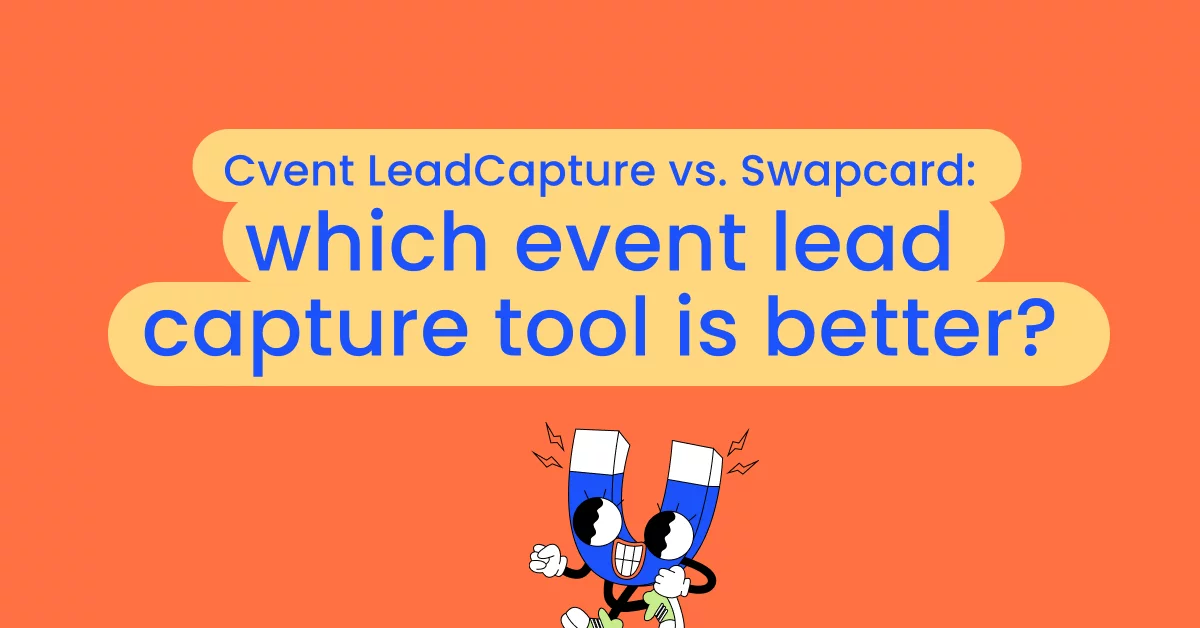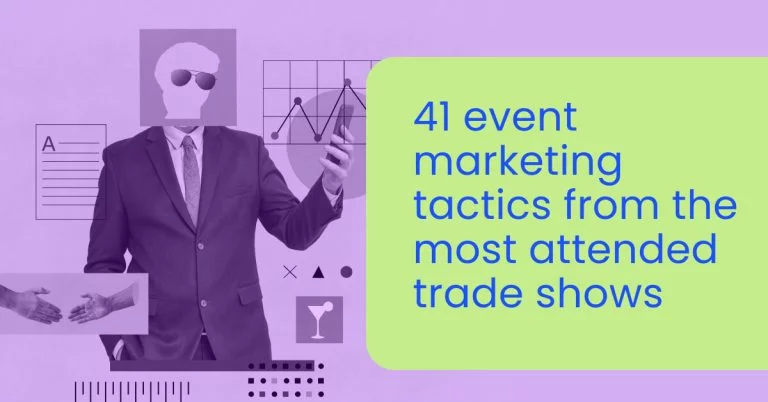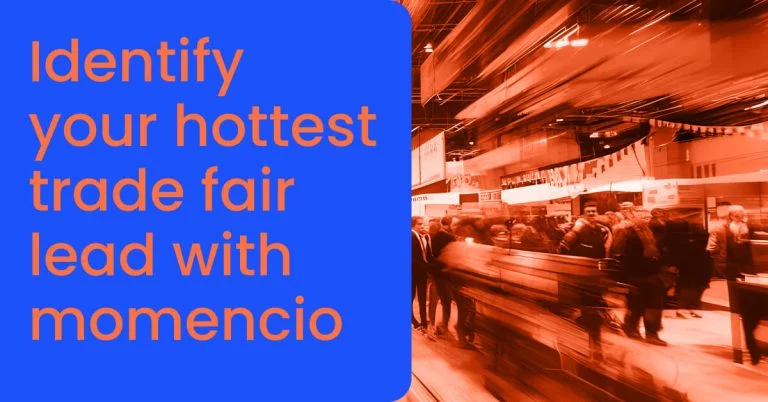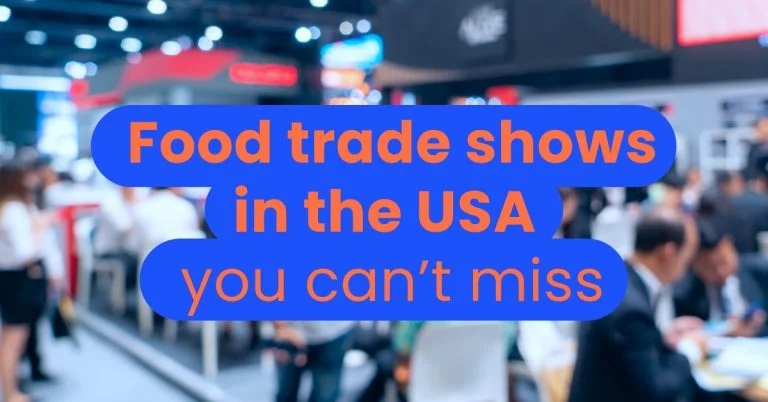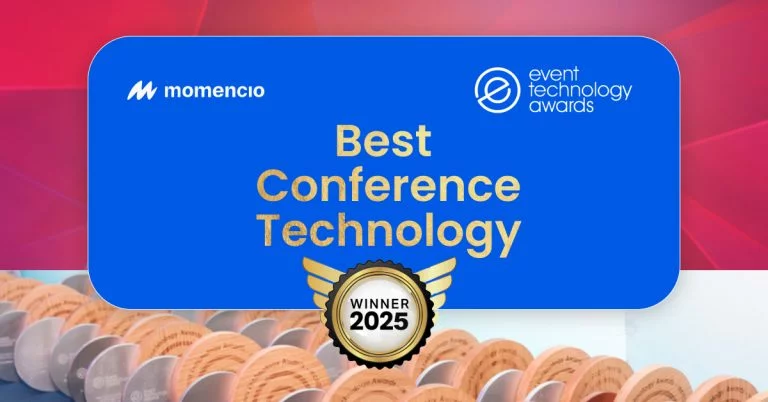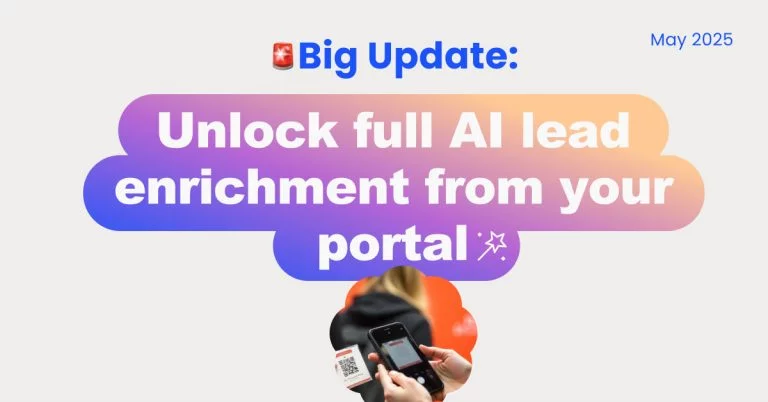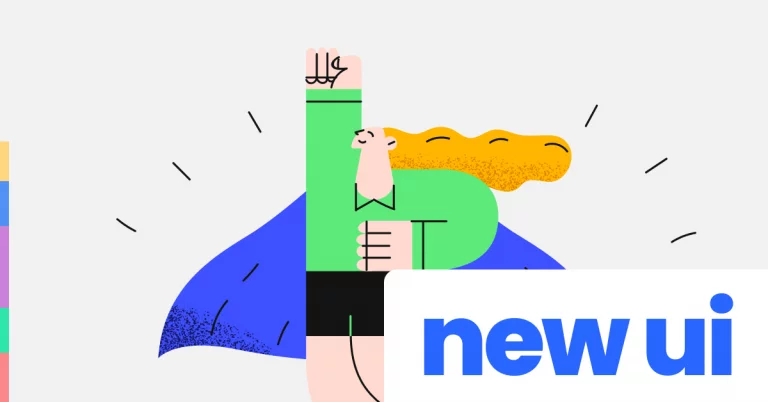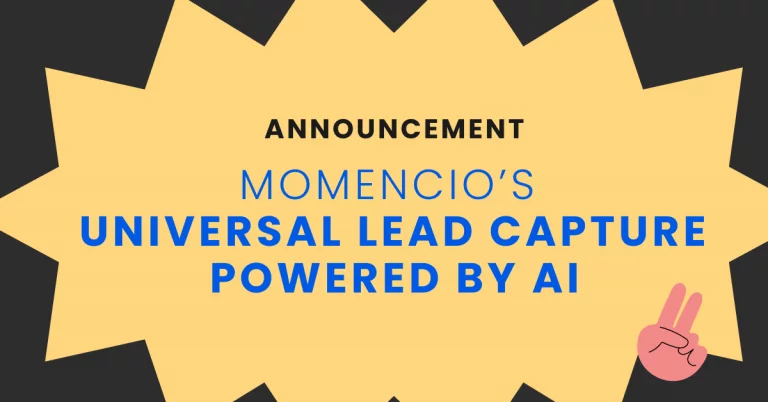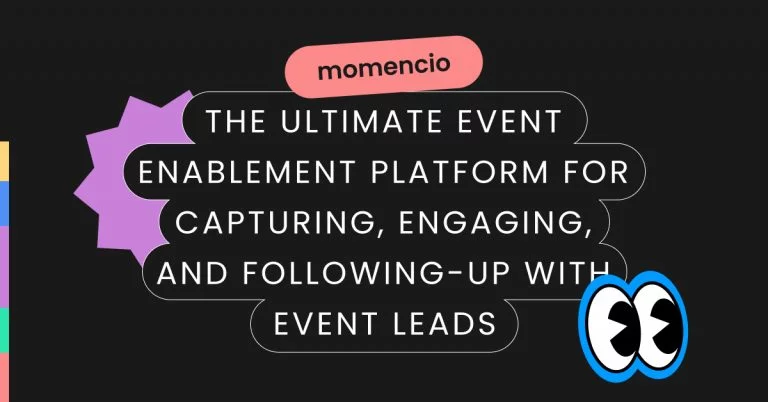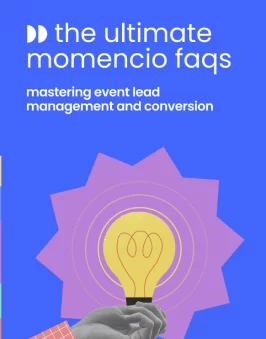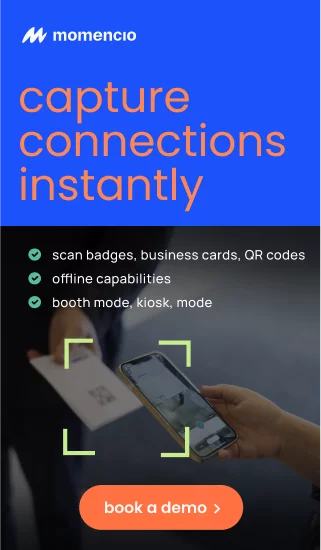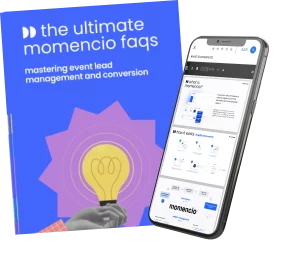As we present a detailed analysis of Cvent Leadcapture vs. Swapcard in this article, it is important to note that very few lead capture tools are built to serve the actual rhythm of modern event teams.
On paper, nearly all platforms promise the same outcomes — seamless scanning, clean data, fast syncs, post-event reporting. But in practice, the difference between one tool and another can mean hours of lost time, inconsistent lead quality, or worse — sales follow-ups that fall flat because the context was never captured in the first place.
This is what makes selecting a lead capture solution deceptively difficult. The core use case is simple. But the success of your implementation hinges on subtleties: how your reps engage at the booth, what gets captured beyond a badge, how quickly data moves to CRM, and how precisely it’s routed to sales. These aren’t checklist features — they’re operational dependencies.
In this article, we’re taking a grounded look at two of the most commonly adopted solutions — Cvent LeadCapture and Swapcard — through the lens of operational fit. Not what’s in their product brochures, but how they hold up when used under actual event pressure: back-to-back conversations, inconsistent Wi-Fi, sales teams with their own agendas, and marketing needing usable data now, not later.
We’ll break down:
- What kind of event environments these platforms are actually suited for
- How they handle lead qualification, syncing, and rep coordination
- What gets lost between capture and conversion — and why
This won’t be a feature-by-feature chart. Because if you’re making this decision, you’ve already seen the demos. You’re looking for real-world friction points and strategic alignment — not icons on a grid.
We’ll also introduce a third player that isn’t as widely known as the two above but is steadily gaining ground in field marketing and sales environments — momencio. Not because it’s “disrupting the industry,” but because it’s architected around how modern teams actually move: fast, lean, and focused on revenue.
If you’ve ever finished an event with hundreds of scanned contacts and no clear path to revenue, this comparison will make your decision easier.
Cvent LeadCapture vs. Swapcard: What these platforms were actually built to solve
At a glance, Cvent LeadCapture and Swapcard both offer a similar promise: scan leads at events, sync them back to your CRM, and give sales something to follow up on. But dig a little deeper, and you’ll find that these two tools were built with fundamentally different assumptions — about the event environment, about user behavior, and about what “lead capture” even means in the broader marketing-to-sales pipeline.
Understanding the original product intent behind each tool is essential, because feature lists don’t reveal operational bias. But when you align a platform’s design philosophy with your specific event environment — expo floor, hosted buyer format, large-scale conferences, roadshows, partner-led activations — the right fit often becomes obvious.
Cvent LeadCapture: Enterprise control for traditional trade shows
Cvent LeadCapture was designed to serve a very specific audience: large-scale enterprise event teams managing conferences, expos, or multi-booth trade shows, often with hundreds of reps and thousands of attendees. Its core strength lies in centralization. The platform assumes that your event lead capture needs to plug cleanly into the broader Cvent ecosystem — including registration, agenda management, check-in, and attendee analytics.
For that type of environment, the value proposition is clear:
- Controlled access: Marketing ops can pre-define forms and lead qualifiers for consistency across reps and booths.
- Integration depth: Seamless connection into Cvent’s full suite allows for strong data unification if you’re already committed to their stack.
- Enterprise scale: The platform handles volume well, and is built with security, compliance, and audit trails in mind.
But that same rigidity can become a liability when agility is required. Many teams we’ve spoken with note that customizing forms on the fly, adapting mid-event based on evolving conversations, or adjusting sales qualifiers across teams is often slower than it should be. If your team operates in a dynamic field environment — with quick pivots, mid-show learnings, and varied sales motions across events — Cvent’s centralized model can feel like overkill.
Cvent LeadCapture works best when events are repeatable, highly structured, and governed by a central marketing authority that values compliance and consistency over adaptability. If your team is optimized for precision and control, this is a strong contender. If you’re optimized for speed and sales fluidity, it may feel heavy.
Swapcard: Engagement-first, lead capture second
Swapcard started as an AI-powered event engagement platform — focused on networking, matchmaking, content discovery, and virtual or hybrid event delivery. Lead capture, in this context, is a layer on top of its broader attendee engagement engine.
What this means in practice is that lead capture is often tied to user actions within the platform: profile views, chat messages, session interactions. It performs best when the bulk of the event activity happens inside Swapcard’s environment — like in-app meetings, content consumption, or messaging. For digital-first event formats, hosted buyer models, or lead-gen events where digital touchpoints matter more than physical scanning, Swapcard can offer rich context that traditional scanners simply can’t deliver.
However, that same model can fall short in high-volume, high-speed, in-person expos or roadshows where reps need fast, responsive tools and can’t afford to rely on attendee app adoption. Many field teams report that the platform’s lead capture tools feel secondary — built more for data collection after digital interaction than as a frontline sales enablement tool.
So, if your event strategy is focused on deeper engagement across content, virtual booths, or hybrid participation — Swapcard’s event graph can offer useful behavioral insight. But if your core objective is rapid lead intake, qualification, and CRM-ready syncs from physical booths, you may find that the platform doesn’t move fast enough where it counts.
momencio: Built for conversion, not just collection
While we’ll go deeper into momencio later in this article, it’s worth noting how its foundational use case differs from both Cvent and Swapcard. momencio is designed around a specific pain point: what happens between lead capture and revenue. It doesn’t assume you’re trying to build an all-in-one event app or that you need a massive enterprise suite. Instead, it’s engineered for teams that want fast capture, instant context, and real sales follow-up — not just scanned names in a spreadsheet.
It supports real-time CRM syncs, dynamic content presentation at the booth, lead scoring, qualification, and intelligent routing. That’s a fundamentally different lens than either Cvent (control) or Swapcard (engagement). We’ll explore where this focus creates a distinct operational advantage in later sections.
The key takeaway
Choosing between these tools starts with understanding the assumptions baked into them. Cvent assumes you’re running scaled events where control and consistency are paramount. Swapcard assumes you want to foster digital engagement and use behavior data to infer intent. momencio assumes you want sales to have what they need immediately after the badge is scanned — and that your job isn’t done until the follow-up begins.
This is less about feature parity and more about choosing a model that mirrors your go-to-market reality. Because while any tool can scan a badge, not every tool is built to move leads into revenue — and certainly not at the speed most modern event teams now operate at.
Booth-level execution — The test most tools fail quietly
The booth is where technology either proves its value or becomes invisible under pressure. No slide deck or onboarding webinar can replicate the lived experience of reps handling 40+ conversations a day, scanning badges between distractions, and logging just enough context for sales to act on. Booth-level performance is not about design aesthetics — it’s about speed, clarity, stability, and control in a fast-moving environment.
Let’s break down how each platform performs in the field — specifically in the hands of the people actually using it: booth staff, field marketers, and sales reps.
Cvent LeadCapture: Built for control, but not always for the rep
Cvent’s lead capture product is fundamentally built for centralized governance. It’s designed for marketing teams that need to deploy a consistent form structure, enforce data fields, and control what’s collected across dozens or hundreds of reps. This is useful for enterprise-level events where process enforcement is critical.
However, this structure often comes at the cost of field flexibility.
Most teams report that reps at the booth can’t adapt fast enough if the form needs modification mid-event. Adding a qualifier, changing a question, or updating lead routing criteria typically requires admin access — and often IT or HQ support. In a real-world setting, that slows things down.
The UI also demands a level of precision and familiarity that assumes proper rep training. In reality, reps are often temporary staff, third-party partners, or sales team members working off minimal onboarding. If they don’t know exactly where to tap, features like note capture or lead scoring get skipped entirely.
Offline mode exists, but syncing post-event is clunky, especially if multiple devices have been used and admins haven’t structured access carefully. On top of that, scanning performance — especially in poor lighting or crowded spaces — is inconsistent. For a platform operating at this scale, that gap is notable.
Cvent performs best when:
- Events are large, repeatable, and process-heavy
- Data consistency is more important than speed
- Field teams are tightly managed by central ops
Where it falters is in:
- Mid-event adaptability
- Rep-level ease of use
- Context capture beyond form fields
Swapcard: An attendee-first platform with secondary capture capabilities
Swapcard was never built as a dedicated lead capture tool. It’s an event engagement platform first — designed to create digital touchpoints between attendees and exhibitors, especially in virtual and hybrid formats. Its lead capture capability exists, but it’s layered over an attendee-driven experience.
This design shows at the booth. Scanning badges is possible but not optimized for high-throughput. Reps who are used to fast, low-friction scanning workflows often find the process awkward. Swapping between lead view, notes, follow-up content, and scoring feels unintuitive in physical event settings.
The core assumption in Swapcard’s architecture is that the attendee is engaging via their own app: booking meetings, favoriting sessions, or initiating chats. That creates useful behavioral data, but it’s passive and depends on attendee behavior — not proactive rep action.
When reps do try to capture context — like specific objections, purchase timelines, or content shared — the interface doesn’t make it easy. Many users resort to typing in open text notes or skipping these inputs altogether. This makes post-event CRM data shallow and inconsistent.
Swapcard performs best when:
- The event is digital-first or hybrid
- Attendee engagement is tracked via app
- Lead capture is secondary to content or networking
It struggles when:
- Reps are scanning dozens of leads per hour
- Fast qualification and note capture is essential
- Internet access is unreliable
momencio: Purpose-built for fast reps and faster sales alignment
momencio flips the assumptions made by both platforms. Its lead capture system is not layered onto a larger suite or designed as a side function — it’s the product.
That shows in its rep experience. From first tap to final submission, the interface prioritizes speed, qualification depth, and post-event usability.
Reps can:
- Scan a badge (or manually add a lead) in seconds
- Qualify using customized tags set by marketing
- Log quick notes using preset prompts or voice-to-text
- Share sales content with the lead on the spot (and track what was shared)
- Trigger lead prioritization or alerts for follow-up within the system
What makes it stand out is how seamlessly the captured data maps to CRM workflows. Sales doesn’t get a flat list. They get leads with context: buyer role, interest type, shared assets, priority level — all timestamped and routed in near real-time.
Offline functionality is built-in, not patched in. Everything is queued and synced automatically. No manual uploads. No risk of lost data if the booth disconnects.
Most importantly, momencio is designed for iteration mid-event. Marketing teams can push changes to forms, update qualifying fields, or adjust rep permissions instantly — without disrupting the workflow.
momencio excels when:
- Field reps need speed and context
- Sales needs immediate, actionable lead data
- Marketing wants to control structure but not limit agility
The trade-off? It’s not a one-size-fits-all event suite. If you’re looking for registration, matchmaking, and session tracking all in one place — momencio isn’t trying to be that.
But if your top priority is high-quality lead capture that accelerates handoff to sales, it’s arguably one of the few platforms designed from the ground up to handle that scenario at scale.
Bottom line
The real test of any lead capture tool is what happens at the booth. Not in a sandbox. Not in an onboarding deck. But in the chaos, pressure, and unpredictability of real-world events.
- Cvent delivers control, but at the cost of flexibility.
- Swapcard creates engagement value, but often misses the sales workflow.
- momencio is engineered for capture speed, CRM precision, and field adaptability — because that’s where conversion begins.
This isn’t about features. It’s about removing friction where it matters most — the moment a conversation turns into a lead.
Customization and control — Who really owns the lead capture process?
In an ideal world, every lead capture workflow would be tailor-made for each event, each region, and each sales team’s motion. In reality, most event teams are stuck working around their tools instead of configuring them to fit the way they operate.
This section addresses a critical — and often overlooked — part of the evaluation process: Who actually controls the lead capture experience? And how flexible is that control in practice?
Because it’s not enough for a platform to offer “customizable forms.” The real question is: Can you actually adjust what matters, when it matters, without breaking things or waiting days for support?
Let’s break this down across four dimensions of control that matter most:
1. Field customization: Can your reps adapt to conversations on the fly?
Events are unpredictable. Some conversations stay high-level, others go deep. Some attendees know exactly what they want. Others ask unexpected questions. What your reps need is the ability to qualify leads in a way that reflects the tone, depth, and context of each interaction — not just check a box.
| Cvent LeadCapture | Swapcard | momencio |
| Pre-event configuration is strong. You can define qualifiers, set lead forms, and apply role-based controls. But during the event, making any changes typically requires admin access and system-level intervention. That means your reps are stuck with whatever was decided days (or weeks) prior, even if it no longer fits the tone of the booth conversations. | Form customization is limited and often tied into broader platform workflows. Since lead capture is not the platform’s primary focus, form-level control is rarely flexible on-site. Reps are expected to operate within the structure set at the event level — usually driven by the event organizer or virtual engagement logic. | Built for in-field adaptability. Marketing can push updates to forms during the event, without disrupting active sessions. Reps can be granted flexible input fields, and forms can branch dynamically based on lead type or role. This enables quick pivots when a new use case emerges or a common qualifier becomes irrelevant. |
If you’re running events where the conversation shifts often — or you’re piloting a new messaging framework — having a system that evolves with your reps is a strategic advantage. Only momencio supports that kind of responsiveness without needing backend support.
Access control: Who owns the data, and who can change what?
It’s not just about what you can change. It’s also about who is allowed to do it — and how granular that control can be. For large teams with multiple roles (sales, marketing, partner reps), this matters more than people realize.
| Cvent LeadCapture | Swapcard | momencio |
| Offers detailed role-based access, but again, changes are centrally controlled. If someone at HQ hasn’t anticipated a need, on-site users can’t fix or update it. In many cases, you’re relying on support tickets or waiting for internal IT to unlock a feature. | Access is tied to event platform roles — primarily driven by the broader event ecosystem. This works fine for organizers and virtual teams but gives limited visibility to exhibitors trying to manage internal hierarchies or external partner reps. | Admins can define permissions per user, per event, and even per device. Want your reps to edit notes but not export leads? Need your regional manager to edit the qualifier logic but not access all submissions? That level of granularity exists. And it’s usable — without calling support or reading a manual. |
The ability to maintain control without sacrificing rep independence is rare. momencio nails this balance by offering structured permission models that still let field teams move fast.
Workflow configuration: Does the system match your sales cycle?
Capturing a lead is just step one. How that lead gets scored, enriched, and routed matters far more. The smartest event marketers don’t just think in terms of scanning — they think in terms of pipeline flow.
| Cvent LeadCapture | Swapcard | momencio |
| Offers limited lead scoring or routing logic out-of-the-box. You can tag or rate leads manually, but connecting those actions to downstream workflows (like CRM campaigns or SDR queues) often requires additional integrations or middleware. Most teams handle this post-event via Excel or custom APIs. | Relies heavily on user behavior signals — profile views, meeting activity, session attendance. While valuable for post-event analysis, it lacks native tools to support lead prioritization or intelligent routing based on rep input.
|
Scoring, tagging, and routing are native to the experience. You can assign lead priority levels, segment by interest type, and instantly sync leads into CRM or MAP with those attributes intact. No need to wait for post-event processing. The system mirrors how your sales team wants to work — and helps marketing hand off leads with actual context. |
If your team is struggling with misaligned follow-ups, lost notes, or slow lead handoff — this is where most tools quietly fail. momencio solves this upstream by embedding those workflows into the capture process itself.
Multi-event consistency: Can you build, reuse, and evolve?
Whether you’re running five events or fifty, every event adds complexity — different audiences, verticals, sales narratives, and booth staff. The ability to reuse, templatize, and refine capture workflows over time is essential to scale without duplicating effort.
| Cvent LeadCapture | Swapcard | momencio |
| Allows form templates and repeatable logic, especially when used within the Cvent event suite. But updates require planning cycles, and managing variations across events isn’t always intuitive. There’s little room for experimentation without full deployments. | Not designed for reuse at the form level. The focus is on content and attendee engagement. Capture workflows are built per event — which can create overhead if you’re managing multiple expos across geographies. | Built for reuse. Teams can duplicate previous event setups, tweak lead forms, modify user permissions, and launch in minutes. That means you’re not building from scratch each time — you’re evolving your system with each event. And it gets smarter with every use. |
This is a huge operational lift-saver for teams managing both large shows and smaller roadshows — giving consistency without rigidity.
Summary
Customization isn’t a bonus feature — it’s a necessity for teams who run dozens of events with different goals, personas, and sales narratives. The right lead capture tool should allow your reps to move fast, your marketing team to maintain control, and your sales team to get leads that are actually usable.
- Cvent offers rigid control, but that control is slow to adapt.
- Swapcard is limited by its engagement-first design.
- momencio combines central oversight with field agility — allowing your team to fine-tune how leads are captured, qualified, and handed off at scale.
If you’ve ever had to manually clean lead data after an event — or worse, had sales ignore leads due to lack of context — then you already know what poor control costs. The right system doesn’t just capture names. It captures intent. And it hands it off in a way that drives revenue.

CRM and sales integration — Where good leads go to die
Capturing leads is step one. Making them actionable — routing them to the right person, in the right format, with the right context — is what separates tools that help marketing log success from tools that help sales close deals.
The problem? Most lead capture tools treat CRM integration as an afterthought. They sync static data into the CRM, often missing timing, qualification logic, and sales readiness markers. That might satisfy a checkbox in the platform’s feature list — but it breaks the sales motion.
This section evaluates how Cvent LeadCapture, Swapcard, and momencio handle post-event handoff, and whether they actually serve the next function in your revenue funnel: turning captured interest into pipeline.
Integration is not the same as impact
Nearly every tool today claims it “integrates with your CRM.” But integration by itself is meaningless unless it creates momentum.
Here’s what real CRM integration should look like:
- Lead data is synced within minutes, not days.
- The CRM record contains contextual signals: priority, interest area, rep notes, shared content.
- Leads are routed to the right owner or SDR queue without manual intervention.
- The follow-up action is predefined and triggered based on lead attributes.
- Sales gets a clean list they can act on — without asking for clarification.
Let’s see how each tool stacks up against this standard.
Cvent LeadCapture: Structured export, disconnected experience
Cvent is designed to play well within its own ecosystem — and when your CRM setup mirrors that ecosystem, integrations are stable and secure. The platform offers both manual and automated export options, and supports integrations with major CRMs like Salesforce and HubSpot via the Cvent Integration Hub.
However, the challenge is depth and timing.
In most implementations, the data that gets synced is flat: name, company, email, maybe a few custom fields. Context — like rep-entered notes, lead ratings, content shared during the event, or urgency tags — is often left out or inconsistently captured. Sales teams regularly report that by the time they receive the lead list, the context is either missing or out of date.
Even when configured to sync nightly or hourly, there’s still a significant delay from the time a lead is captured to when it’s visible in the CRM. That kills the ability to follow up while the conversation is fresh — and leaves the burden of interpretation on sales.
Also, mapping fields between Cvent and your CRM often requires involvement from your IT or RevOps team, especially when using the broader Cvent suite. For many mid-sized teams, this overhead becomes a barrier to real-time agility.
In short:
- Data syncs, but not always the right data.
- Timing is slow.
- Context is limited.
- Sales teams inherit a list, not insight.
Swapcard: Behavioral data, but weak alignment with sales systems
Swapcard shines when it comes to engagement tracking. It collects valuable behavioral signals — session attendance, meeting bookings, content views — especially in virtual or hybrid events. These data points are useful for marketing teams trying to analyze attendee intent.
But that strength doesn’t translate cleanly into CRM actionability.
For most teams, syncing Swapcard data into the CRM is a manual or semi-automated process. The platform can generate reports, but exporting and aligning them with sales workflows takes work. There’s no out-of-the-box, event-to-CRM pipeline that prioritizes leads based on captured behavior and routes them to reps instantly.
Even if the behavioral signals are valuable, they require interpretation. Was the attendee’s interest real? Were they just browsing? Without rep-level qualification or immediate sales context, sales teams often dismiss these leads as “marketing noise.”
Also, because Swapcard is attendee-first and often managed by the event organizer, exhibitors have limited influence on what gets tracked, how it’s tagged, and where it goes. This results in uneven data sets, inconsistent fields, and delays in routing.
Bottom line:
- Good for long-term engagement scoring.
- Weak for immediate sales execution.
- Integrations are either basic or heavily customized.
- Sales follow-up is delayed and often misaligned.
momencio: Purpose-built for sales follow-through
This is where momencio is fundamentally different.
The platform doesn’t just push leads into the CRM — it prepares them. Every lead is packaged with:
- Qualification tags (pre-set by marketing, applied by reps).
- Lead priority scores (based on role, interest, or urgency).
- Time-stamped notes, written at the booth.
- Content shared during the interaction.
- Rep assignment and source event data.
And it happens in real time.
As soon as a lead is captured, it flows directly into your CRM, segmented and prioritized — no CSVs, no lag, no manual cleanup. This allows SDRs or AEs to follow up within hours, with clear knowledge of what was discussed, what the prospect saw, and what they asked for.
In most setups, momencio can push leads directly into Salesforce, HubSpot, Zoho, or any major CRM using pre-built connectors. Custom field mapping, lifecycle stage tagging, and routing logic are baked into the setup — without requiring IT to step in each time.
It also offers two-way sync. If a rep updates lead status or adds notes in the CRM, momencio reflects that change. This creates full visibility across both systems and ensures marketing can track not just capture, but conversion.
As a result:
- Sales gets leads they trust.
- Marketing sees downstream movement.
- The entire team works from the same timeline.
If you’re serious about aligning event performance with pipeline velocity, this is the level of integration you need — not a nightly export.
Final verdict
This section often gets buried under “we support Salesforce” checkboxes — but it’s where the real business impact lives.
- Cvent gives you predictable exports, but limited flexibility.
- Swapcard gives you activity data, but not sales alignment.
- momencio gives you qualified, sales-ready leads in real time — and routes them with context.
If your event strategy is tied to revenue targets — not just attendance — then what happens after the booth matters more than what happens in it. Your lead capture tool needs to connect the two. Only one of these three was built specifically for that.
Analytics that actually matter — From post-event reporting to performance insight
Most event teams don’t lack data. What they lack is clarity.
A lead count means nothing if you don’t know who those leads are, how qualified they were, what they engaged with, and whether they moved through the funnel. Yet, a surprising number of lead capture tools still measure success in terms of “leads scanned” or “badges captured” — metrics that might satisfy the surface, but offer no strategic value when it’s time to present results to sales, leadership, or the board.
This section evaluates how Cvent LeadCapture, Swapcard, and momencio deliver on post-event analytics — not as dashboards, but as decision-making tools. Because the real value of lead capture data is not in looking back. It’s in knowing what to do next.
Cvent LeadCapture: Event summaries, not sales intelligence
Cvent provides post-event reports through its LeadCapture dashboard and broader Event Cloud platform. You get the usual basics: number of leads captured, top-performing reps (based on scan volume), average rating (if used), and download-ready exports for analysis.
For trade shows and large conferences, these summaries are helpful to benchmark surface performance across reps and events. If your goal is to validate rep activity or measure booth footfall, Cvent delivers.
But the problem is: that’s where the insight often stops.
Cvent doesn’t natively provide visibility into:
- Content engagement (what was shown or shared at the booth)
- Lead movement after handoff (follow-up timing, conversion progress)
- Buyer persona patterns (roles, verticals, intent)
- Time-based heat maps of peak engagement
- Pipeline influence from captured leads
To get these, marketing teams often resort to exporting spreadsheets, enriching lead records manually, and creating pivot dashboards outside the platform. For enterprise ops teams with dedicated analytics resources, this is manageable. For leaner teams — or those managing multiple events — it’s a workflow bottleneck.
Cvent’s analytics are useful for post-mortem reporting, but they rarely drive real-time decisions or inform next-event strategy without additional tooling.
Swapcard: Deep engagement insights, shallow lead intelligence
Swapcard’s analytics engine is strong when it comes to user behavior within its platform. It can tell you:
- Which sessions were most attended
- How many meetings were booked
- Who visited your booth (digitally or physically)
- What content was consumed or downloaded
- How many chats or messages were exchanged
This is valuable for understanding digital engagement — especially for hybrid events or high-content formats. Marketing teams looking to prove session value, speaker influence, or content reach will find useful data here.
But when it comes to understanding lead quality — or sales readiness — Swapcard doesn’t go deep enough.
Here’s what’s missing:
- Lead prioritization based on interaction + qualification
- Conversion tracking post-export
- Reporting by rep or team
- Insights that tie booth behavior to revenue motion
- Immediate visibility into which leads are follow-up ready
What’s more, most of the engagement data lives inside Swapcard’s environment. Once exported, it becomes fragmented or contextless unless you stitch together custom reporting — something most exhibitors won’t have time or control to do.
In short: Swapcard’s analytics are excellent for platform performance. But they don’t translate easily into sales action — especially when reps need to prioritize who to follow up with and why.
momencio: Real-time insight, tied directly to pipeline outcomes
momencio treats reporting not as a summary of what happened — but as a system for deciding what happens next.
Its analytics engine operates on two levels:
Real-time booth intelligence:
During the event, marketing and sales managers can see:
-
- How many leads have been captured per rep, per hour
- Which content pieces are being shared the most
- What types of leads are being tagged (e.g. decision-makers vs. influencers)
- Priority scores and follow-up status in real time
- Engagement breakdown by vertical, product, or campaign
Post-event sales enablement:
As soon as the event ends (or even during), the system provides:
-
- A full breakdown of high-priority leads, with rep notes
- Auto-grouped lead lists for SDRs by urgency or segment
- Attribution dashboards that show content performance vs. lead quality
- CRM sync reports with conversion tracking built-in
- Event performance summaries across campaigns, not just events
This makes the difference between “event data” and “sales intelligence.” With momencio, you’re not just measuring volume — you’re measuring velocity: how quickly your leads are converting, who’s following up, and where the revenue is building.
For marketing ops and field teams, this means:
- No spreadsheets
- No manual list cleaning
- No chasing reps for context
- No delay in answering “what did we actually get out of this?”
For sales, it means:
- Clear targets
- Immediate priority
- Actual lead context, not just contact info
Because the system ties activity to CRM, you can measure lead quality by actual downstream behavior — not just scan counts. If a content asset correlates with a higher close rate, you’ll know. If certain reps consistently convert leads better, you’ll see it. And if an event underperforms, you’ll have the data to justify budget adjustments.
This level of clarity turns post-event reporting from a static export into a continuous feedback loop.
Final word
Analytics shouldn’t be cosmetic. They should inform what happens next — from sales motions to strategic event planning.
- Cvent gives you static summaries — enough for activity reports, not enough for sales readiness.
- Swapcard gives you strong attendee engagement data — but little operational follow-through.
- momencio gives you lead-level insight tied to pipeline — and the ability to act on it, before the event even ends.
If your post-event reporting still lives in Excel, or your sales team is still asking “who are these leads?”, then the analytics aren’t working. You don’t need more data. You need smarter insight, tied to revenue. And only one of these platforms is architected to deliver exactly that.
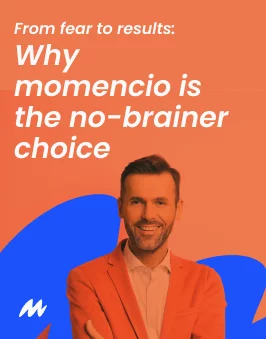
Pricing transparency and scalability — What will it really cost to grow with each platform?
Most lead capture platforms avoid talking about pricing in concrete terms. Enterprise vendors bury costs in bundles. Platform-first tools force you into broader ecosystems. And almost no one tells you what it’ll cost when your use case scales beyond a single event or a single team.
But if you’re a VP of Sales or Director of Field Marketing, this is not a trivial line item. It’s a recurring operational expense that scales with the number of reps, events, and territories you activate. If the pricing model doesn’t match your actual usage patterns — or if it punishes flexibility — you’re going to feel that friction quickly.
So let’s break down how Cvent LeadCapture, Swapcard, and momencio approach pricing, and what that means for your event and sales operations long-term.
Cvent LeadCapture: Enterprise-scale control, enterprise-scale pricing
Cvent follows a traditional enterprise software model. Its pricing is typically tied into the broader Cvent Event Cloud suite, meaning lead capture is often bundled with other modules like registration, session management, check-in, and attendee tracking.
This is fine if you’re all-in on the Cvent stack. But if you’re only looking to improve your lead capture workflows — without buying into the rest of the platform — things get expensive, fast.
What to expect:
- Seat-based pricing: Each user license comes at a cost. Add 10 reps for a new show? That’s 10 more licenses.
- Per-event fees: Many contracts charge per event instance or per deployment, which penalizes frequent users.
- Support and integration add-ons: CRM integration or custom workflows often require professional services or technical support fees.
Most importantly, pricing is non-transparent. There’s no public rate card. Everything goes through custom quotes, making budget forecasting and vendor comparisons difficult without deep procurement cycles.
Cvent works best when:
- You’re already using its full event suite
- You run large, predictable events
- You’re okay with top-down control and centralized IT ownership
It becomes a challenge when:
- You need flexible seat counts across events
- You’re scaling rapidly
- You want leaner, rep-driven execution without platform overhead
Swapcard: Platform-first pricing, with limited standalone options
Swapcard is positioned as an event engagement platform, not a lead capture tool. So its pricing is based on event size, features activated, and platform access levels.
What this means practically:
- Lead capture is a module, not the core product. You can’t typically buy it à la carte.
- Pricing varies based on the number of attendees, sessions, networking features used, and content integrations.
- For many exhibitors, lead capture is included as a feature if the event organizer is already using Swapcard — but not something they directly manage or pay for independently.
This creates a lack of clarity and control:
- You may not know what you’re paying specifically for lead capture.
- You may not be able to expand usage unless the organizer upgrades their plan.
- You’re often tied to the feature set allowed by the event’s main contract — not what your team actually needs.
In short, Swapcard is useful if you’re an organizer managing a digital-first experience. But for exhibitors or sales teams looking for dedicated, customizable lead capture — especially across multiple events — the pricing model isn’t built to support that use case.
Swapcard works best when:
- You’re running or sponsoring digital-heavy events
- Lead capture is a nice-to-have, not a critical workflow
- You value attendee behavior data more than sales pipeline precision
It doesn’t scale well when:
- You want standalone deployment
- You need rep-specific customization
- You want usage-based flexibility
momencio: Modular pricing built for teams that move fast
momencio takes a refreshingly transparent approach to pricing — one that favors teams who run frequent events, scale reps up and down, and don’t want to be locked into bloated annual contracts or bundled software suites they won’t use.
Unlike Cvent or Swapcard, momencio’s pricing is modular and usage-based, structured around how often and how extensively you actually deploy it — not just how big your event is.
Here’s how it works:
- You choose a plan based on the depth of functionality you need — from streamlined lead capture to fully-automated follow-up and engagement.
- You pay per user or per event, depending on your team’s structure.
- You can scale your plan up or down quarter-to-quarter, without triggering re-scoping or renegotiation.
There’s also a single-event option designed for one-off use cases — like pilot projects, seasonal activations, or regional roadshows — allowing teams to experiment with the platform without committing to a long-term license.
What makes this approach effective:
- You’re never paying for features you don’t use.
- You can expand only when your team’s workload increases.
- You don’t need IT or procurement to step in every time your field strategy evolves.
For marketing teams running lean activations, or sales organizations coordinating dozens of events a year across regions, this pricing model aligns with reality — not legacy enterprise structures.
In contrast to platforms that reward volume but penalize flexibility, momencio is built to scale on your terms — fast, clean, and without unnecessary weight.
Summary: Predictable cost is not the same as flexible value
Cvent and Swapcard each represent common pricing traps:
- Cvent: comprehensive but rigid, with hidden implementation overhead.
- Swapcard: feature-rich but inaccessible as a standalone, exhibitor-owned solution.
momencio fills a specific gap in the market — pricing that favors operational agility and high-frequency teams who don’t want to buy into a platform just to fix a broken handoff between the booth and the CRM.
For procurement teams, it also offers a more predictable and budget-friendly way to scale without compromise. Because in high-stakes, multi-market environments, every rep, every event, and every quarter counts — and your tool should match that rhythm without becoming a burden.
User feedback — What real teams are actually saying
Sales decks and product tours are controlled environments. Review platforms and peer discussions, on the other hand, are where tools get exposed — not just for their features, but for how they behave in the hands of event marketers, sales teams, and field reps.
This section synthesizes user reviews from platforms like G2, Capterra, TrustRadius, and peer communities to evaluate what customers are actually experiencing with Cvent LeadCapture, Swapcard, and momencio. We’re not interested in vanity scores. We’re looking for recurring patterns — both in praise and in frustration.
Cvent LeadCapture: Stable for enterprise events, slow to adapt
Across hundreds of reviews, Cvent LeadCapture earns consistent marks for stability and control. Enterprise users appreciate its ability to enforce structure, integrate within the broader Cvent Event Cloud ecosystem, and offer centralized oversight for large teams.
However, reviewers repeatedly flag the following issues:
- Steep learning curve: Users often describe the interface as unintuitive for first-time reps, requiring formal training or guidance.
- Limited in-event flexibility: Many teams reported being unable to make form edits or workflow adjustments during an event — a significant drawback in fast-changing booth environments.
- Delayed access to leads: Several users mention lag time between capturing a lead and seeing it in the CRM, especially when syncing is scheduled or requires manual exports.
- Data depth concerns: While lead scanning works reliably, reps often struggle to add useful context, and sales teams complain about receiving “flat” leads without notes or engagement insights.
Who it works well for:
- Organizations using the full Cvent suite.
- Large-scale, pre-structured events where rep behavior is tightly managed.
- Centralized teams with dedicated ops support and long event planning cycles.
Where users feel friction:
- Mid-event adaptability.
- Rep experience and speed.
- Real-time CRM handoff and follow-up readiness.
Swapcard: Great for engagement, less effective for capture precision
Swapcard earns strong marks from organizers and attendee-focused marketers. Its user interface is widely regarded as clean, intuitive, and powerful for virtual or hybrid engagement. Attendees enjoy the networking features, and organizers benefit from data on content consumption and session behavior.
That said, reviews from exhibitors and sales-focused users paint a different picture.
Common feedback includes:
- Lead capture feels secondary: Exhibitors report that while badge scanning exists, it’s not optimized for speed or rep workflows. Some even refer to it as “bolted on” rather than core functionality.
- Limited control for exhibitors: Because organizers control most of the configuration, exhibitors often have little say in how lead forms work or what fields are required.
- Poor follow-up readiness: Sales teams receive lead data lacking prioritization or context — often just names and interactions without qualifiers or notes.
Users like Swapcard when:
- The event is virtual or hybrid.
- Attendee networking is a primary goal.
- The platform is used as a holistic event system — not just lead capture.
Users are frustrated when:
- They need fast, contextual lead capture during live events.
- Sales enablement is a key KPI.
- They’re attending events run by third parties and lack admin-level access.
momencio: Fast, rep-friendly, and purpose-built for lead-to-revenue conversion
What stands out most in momencio reviews is consistency — especially among field marketers, event ops leads, and sales enablement roles. The praise doesn’t come from platform fanfare or UI aesthetics, but from the tool’s ability to remove friction in the day-to-day realities of event execution.
Key strengths highlighted by users:
- Built for booth reps: Multiple reviewers mention how little training is needed. Reps can scan, qualify, and send follow-ups in under a minute — even if they’ve never used the tool before.
- Flexible and customizable: Marketing teams appreciate how fast they can launch new events, update lead forms mid-show, and configure workflows without calling IT.
- Instant CRM sync with context: Sales teams regularly note that leads show up in their pipeline with tags, notes, content history, and a clear priority. Follow-ups happen faster — and feel more informed.
- Outstanding support: Users consistently mention fast response times from the momencio team and a willingness to solve small issues without delay.
Areas for improvement (based on critical reviews):
- Interface polish: A few users note that while functional, the UI isn’t as slick as some modern SaaS tools. However, they’re quick to add that performance outweighs cosmetic appeal.
- Learning curve for advanced features: Some newer users mention a slight learning curve when setting up automation or integrating with custom CRMs, though this is often offset by hands-on support.
Best suited for:
- Mid-sized to large teams who prioritize sales-readiness over event engagement.
- High-frequency event programs that need repeatable, scalable workflows.
- Organizations that want lead capture aligned with sales—not just marketing.
Common user sentiment:
- “It just works.”
- “Our reps stopped complaining.”
- “Sales follows up faster than ever.”
The pattern is clear
- Cvent is stable, trusted, and enterprise-ready — but not agile. It serves centralized teams well, but limits flexibility for those who need real-time iteration and rep-led execution.
- Swapcard shines as an engagement layer, but struggles as a dedicated lead capture tool. It’s ideal for organizers, not always for exhibitors.
- momencio consistently earns praise for speed, adaptability, and CRM alignment — especially from teams who are held accountable not for lead count, but for sales outcomes.
If your lead capture tool is judged not by how it looks, but by how much revenue it helps unlock, user feedback puts momencio in a different class.
Verdict — How to choose based on your priorities
If you’ve made it this far, you’re not looking for feature parity. You’re looking for strategic fit.
You’re trying to answer one question:
Which tool aligns best with the way my team captures leads, moves data into CRM, and supports post-event conversion — consistently, across different types of events, with minimal operational overhead?
Here’s a summary of how each platform stacks up, framed by the real-world pressures field marketers, sales leaders, and event managers face:
Choose Cvent LeadCapture if:
- You’re already committed to the broader Cvent Event Cloud ecosystem.
- Your events are large, structured, and compliance-heavy.
- You need centralized control, predefined workflows, and uniform data collection.
- You have dedicated ops or IT support to manage system configuration and changes.
- Real-time adaptability and rep-led flexibility are less important than control and consistency.
Avoid if: you need mid-event agility, rep-friendly UX, or fast CRM handoff without admin dependencies.
Choose Swapcard if:
- You’re running virtual or hybrid events where attendee behavior inside the platform is key.
- You prioritize content engagement, matchmaking, and networking over direct lead capture.
- You’re the organizer and have admin access to configure the environment.
- Sales-readiness is not your primary outcome — engagement depth is.
Avoid if: you’re an exhibitor or field team that needs fast, actionable lead capture across multiple physical events.
Choose momencio if:
- You run a high volume of in-person events, roadshows, or field activations.
- Your sales team expects warm leads with context, not just badge scans.
- You need real-time CRM sync, lead scoring, content tracking, and rep-level performance visibility.
- You want to scale across regions or events without locking into heavy platform contracts.
- You value operational flexibility — launching new events, adjusting workflows, and iterating without external support.
Avoid if: you’re looking for a full event management suite with agendas, registration, and attendee matchmaking — momencio isn’t trying to be that.
All three platforms can “capture leads.” But only one was built around what happens after the lead is captured.
Cvent focuses on structure and enterprise-wide control. Swapcard emphasizes digital engagement.
momencio was designed to close the gap between interest and action — to get sales what they need, faster, with cleaner context and zero friction.
If your event team is evaluated on pipeline impact, not just lead volume — you already know what matters most: clean data, smart routing, immediate follow-up, and the ability to execute without chasing IT or waiting 48 hours to download a spreadsheet.
That’s where momencio quietly outperforms — not because it does everything, but because it does the right things exceptionally well.
FAQs
- Can momencio integrate with our existing CRM and marketing automation tools?
- Yes. momencio offers native integrations with platforms like Salesforce, HubSpot, and others. It supports real-time, two-way sync, allowing captured leads — along with qualification tags, rep notes, and shared content — to flow directly into your CRM. Custom field mapping and routing logic can also be configured without requiring deep technical resources.
- How quickly can our reps start using momencio at an event?
- Reps can be trained and onboarded in minutes. The interface is designed for fast, intuitive use — even for first-timers or temporary staff. Most teams report that reps can scan, qualify, and send follow-up content within a minute per interaction, without needing walkthroughs or IT support.
- Is momencio suitable for small-scale events or one-off activations?
- Yes. momencio offers a single-event plan that allows smaller teams to deploy the platform for individual shows, roadshows, or pilots — without committing to long-term licenses. This is especially useful for testing the system’s impact before scaling to larger programs.
- What kind of analytics does momencio provide post-event?
- momencio delivers real-time dashboards and post-event reports that include rep-level performance, content engagement metrics, lead scoring summaries, and CRM follow-up activity. These reports help marketing and sales teams prioritize outreach and quantify ROI — without exporting to spreadsheets or building custom dashboards elsewhere.
- Can we adjust lead capture forms or workflows during the event?
